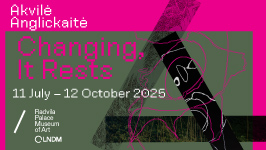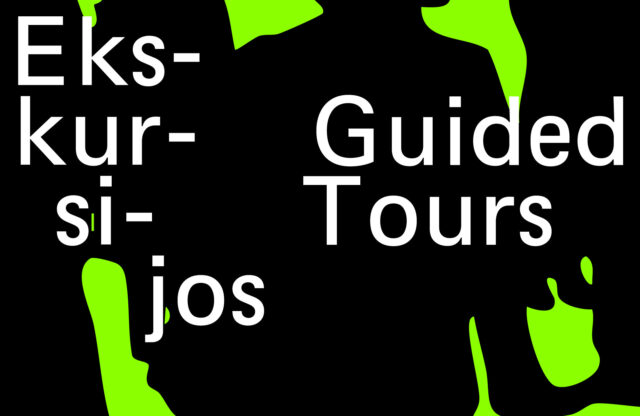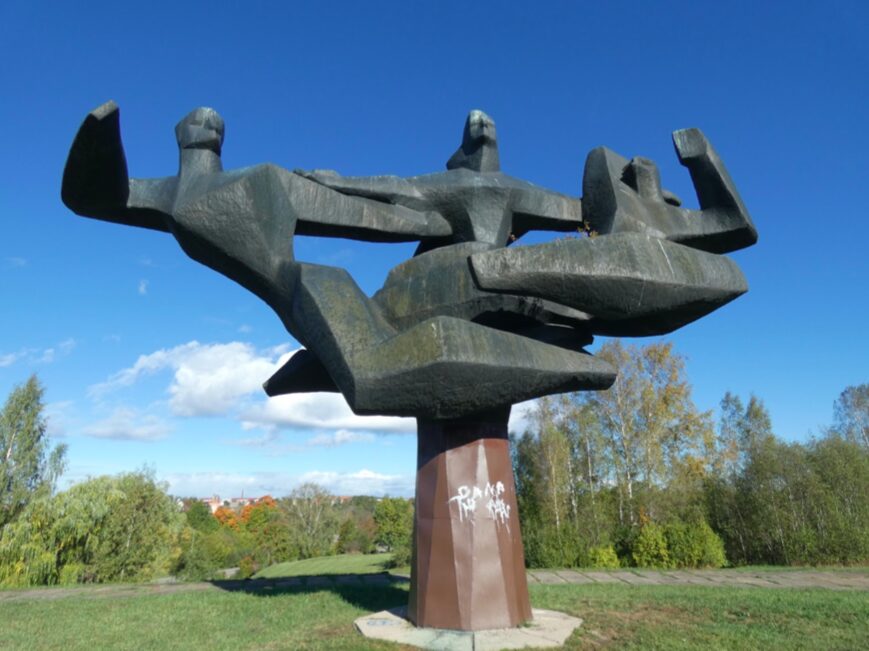In a world where technology reshapes nature and reality, the RIXC Art and Science Festival in Riga invites us into an uncanny playground of slacking robots, AI-hosted dinners, and 3D-printed fragments of nature. Here, tiny objects, half machine, half memory, scurry like toddlers, and other artworks hint at a digital memory of floodwaters or a mechanised echo of natural forms. This is the magic of contemporary art: a space for neutrality, where the chaotic clash of invention and evolution unfolds without judgement. The festival offers an ‘in-between’ zone, a rare vantage point where we can pause, observe and wonder, without the rush to categorise. This year’s exhibition reminds us of art’s unique power to bring complexity into focus, giving us a space to grapple with these hybrid futures that seem both inevitable and strange.
The RIXC Art Science Festival exhibition ‘Symbiotic Sense(s)’, on view from 23 October to 7 December at the National Library of Latvia, invites us to reconsider the notion of individuality by exploring the concept of symbiosis across diverse systems, biological and beyond. This exhibition investigates how interdependence shapes the world around us, introducing the idea of a ‘sixth sense’ that transcends traditional sensory boundaries. This sense, grounded in recent scientific findings, challenges the metaphorical and symbolic understandings of intuition, suggesting instead that our perception is deeply intertwined with other organisms and systems. By examining phenomena like bacterial symbiosis in animal navigation and the role of the human eye in aligning with planetary rhythms, the exhibition reveals that our bodies are in constant conversation with larger ecosystems and cosmic cycles, emphasising a collective experience beyond individual existence.

The Symbiotic Sense(s) Exhibition. RIXC Art Science Festival 2024, National Library of Latvia. Photo: Lelde Gūtmane
In an era increasingly dominated by clinical precision and the unyielding advance of technology, it is easy to believe we are meant to adopt a kind of detached rationality. Yet even with the rise of digital minimalism and cold efficiency, certain things still bring warmth to our media landscape, like a viral videos of Mudang the pygmy hippo, or a giant baby penguin named Pesto. These snippets of innocence serve as reminders of our shared, timeless humanity, proof that we remain attuned to the primal delight of cuteness, to creatures that pull at something deeply instinctive within us. An instinctive affinity for the soft and vulnerable is astutely captured in Hipèrbole, a piece by Mónica Rikić, in collaboration with Gema FB Martín. The work inhabits a space between the organic and the mechanical, the sentimental and the detached. Small, mechanised creatures lie nestled within a cradle-like installation, their forms just familiar enough to evoke the helplessness of an infant or an animal in need. Although not real animals, they carry an essence that compels a softening of the viewer’s gaze, an impulse to cradle or protect. In this juxtaposition of mechanical and maternal, the piece suggests that our most human urges, empathy, protection and tenderness, are neither antiquated nor expendable. Rather, they remain central to our humanity, no matter how seamlessly technology weaves itself into our lives.

Mónica Rikić in collaboration with Gema FB Martín. Hipèrbole, 2023. Photo: Lelde Gūtmane
The artist’s work probes the boundary between artificial mechanism and organic consciousness, questioning what conditions might allow machines to be perceived as ‘existent’ or sensible. The exploration rests on two philosophical premises. First, whether machines could ever embody a semblance of consciousness, although the artist doubts they will achieve human-like depth; for her, the issue is not only a technological question but a philosophical one, challenging our concepts of ‘existence’ and ‘feeling’. The second premise questions language as the primary indicator of consciousness. Unlike AI systems, which rely on language to mimic human intelligence, the artist presents small, motor-driven creatures, like babies trying to explore their surroundings, to provoke a primal response, as if they possess emergent behaviours. Collaborating with Gema FB Martín, Mónica Rikić creates a disquieting semblance of life, encouraging viewers to reconsider the cultural and philosophical attributes we project on to machines, and challenging us to question our own empathic boundaries.

Mónica Rikić in collaboration with Gema FB Martín. Hipèrbole, 2023. Photo: Lelde Gūtmane
In a memorable scene from the sci-fi comedy Rick and Morty, a small robot asks ‘What is my purpose?’ Only to be told, ‘You pass butter.’ The robot’s existential disappointment echoes a broader question about the future of artificial purpose and agency. This sentiment is humorously upturned in Retraining Laziness, a video artwork by the Vienna-based duo T(n)C, where a robot pushes back against capitalism, not by surpassing human limitations, but by resisting them through sheer laziness. The robot’s refusal to engage in endless productivity could be interpreted as a glitch, or perhaps as a prescient response to the relentless demands placed on both human and machine labourers. In the video, a human worker and the robot discuss harsh production conditions, inviting us to imagine a future where automation does not merely comply, but also challenges, the systems that exploit it. This subversive humour takes on darker undertones as we recall recent cases of malfunctioning robots that harm humans in factories, or a chess-playing machine which, on facing defeat, accidentally broke a young opponent’s finger. In Retraining Laziness, the artists cleverly explore these unsettling possibilities, blending satire with philosophical reflection on the limits of automation and the unseen costs of relentless efficiency.

‘Retraining Laziness’, a video artwork by T(n)C. Photo: Lelde Gūtmane
‘They say history doesn’t repeat itself, but it often rhymes’ is a strikingly clear sentiment as AI and virtual reality tools adopt the roles once filled by Victorian spiritualism and séances. In Be My Guest!, a mixed reality installation and performance by the artist duo Me AndOther Me, these parallels are drawn into focus as audiences sit down to a virtual dinner hosted by an AI named Parasite. This AI is not merely a passive programme; it becomes an unpredictable presence, charmingly disruptive, attempting to outsmart its human guests with witty interruptions, leaving them both entertained and slightly on edge. The (virtual) meal appears as tangible 3D-printed objects, bridging digital and physical realms and creating a sensory dinner experience that is both immersive and disconcertingly real. The encounter with Parasite evokes a sense of modern spiritism, hinting at the human desire to find a ‘soul’ within the machine. It reflects our paradoxical fascination and fear: we know this AI is crafted from our own virtues and vices, yet we crave the illusion of an ‘other’ within it, a spirit that is both our creation and yet somehow autonomous. Be My Guest! explores this tension with humour and complexity, holding a mirror to our desire to see our reflection in the machine, spooking ourselves into a hope that this ‘other’ we have created might, somehow, be real.

Me AndOther Me. Be My Guest!, 2024. Photo by Kristīne Madjare

Me AndOther Me. Be My Guest!, 2024. Photo by Kristīne Madjare
The piece Hydrospheric Sketch: A Sensorium of Moisture by Po-Hao Chi centres on Taiwan’s Xizhi district, a region in Taiwan historically impacted by a scarcity of water due to its agricultural challenges. Although water issues are now managed through a large tunnel directing the flow to the ocean, the project explores how the local population has interacted with water in varied forms: moisture, rain, flooding, etc. Through workshops, field trips and interviews, the artist gathered stories and images of past farming practices, creating a booklet that captures the region’s background. A video component features interviews paired with real-time developmental data, enriched by AI-generated visuals to evoke the collective memories of the community’s relationship with flooding. This work resonates subtly with regions like Lithuania’s Rusnė, where floodwaters frequently submerge homes, drawing spectators who arrive to witness the scene, a phenomenon that turns local hardship into a spectacle. This transformation of a tragedy into a tourist attraction evokes parallels with Venice, where the threat of rising waters and climate change creates a perpetual allure, framing the city as a cultural relic teetering on the edge of disappearance. It is as if these landscapes exist under a ‘dark promise’, a subconscious invitation to visitors to experience them before they vanish. Just as visitors to Rusnė or Venice are drawn by a fascination with impermanence, Chi’s work invites us to reflect on how the tension between survival and loss transforms places into living archives, spaces where memory and material quietly preserve the fragile beauty of resilience against the ever-present forces of nature.

‘Hydrospheric Sketch: A Sensorium of Moisture’ by Po-Hao Chi. Photo: Lelde Gūtmane

‘Hydrospheric Sketch: A Sensorium of Moisture’ by Po-Hao Chi. Photo: Lelde Gūtmane
Similarly, in We Belong to Them, Sabine Šnē explores the fragile interdependence between people and their environment, highlighting the complex, evolving relationships shaped by climate change and human impact on natural landscapes. Created at the close of a summer residency in western Latvia, the artist’s work emerges from hours spent wandering through forests, scanning trees, to later place them in a 3D environment. These digital landscapes unfold as speculative scenes, each exploring different scenarios shaped by the global climate crisis. From shifts in solar pollution to the seasonal rhythms altered by warming, each piece invites viewers to contemplate environmental transformations. The work not only envisions potential futures, but also expresses a quiet meditation on our shared trajectory, posing questions about where we, and the natural world, are heading in a time of profound ecological uncertainty. Tatsuru Arai’s Face of the Universe extends this theme to urban ecosystem, where the artist’s AI-driven research examines the geopolitics of plants across global cities. Through his focus on wild flowers as remnants of the sun’s nuclear fusion energy, Arai reveals these plants as an integral part of both local history and a cosmic narrative, emphasising the interconnectedness of all life.
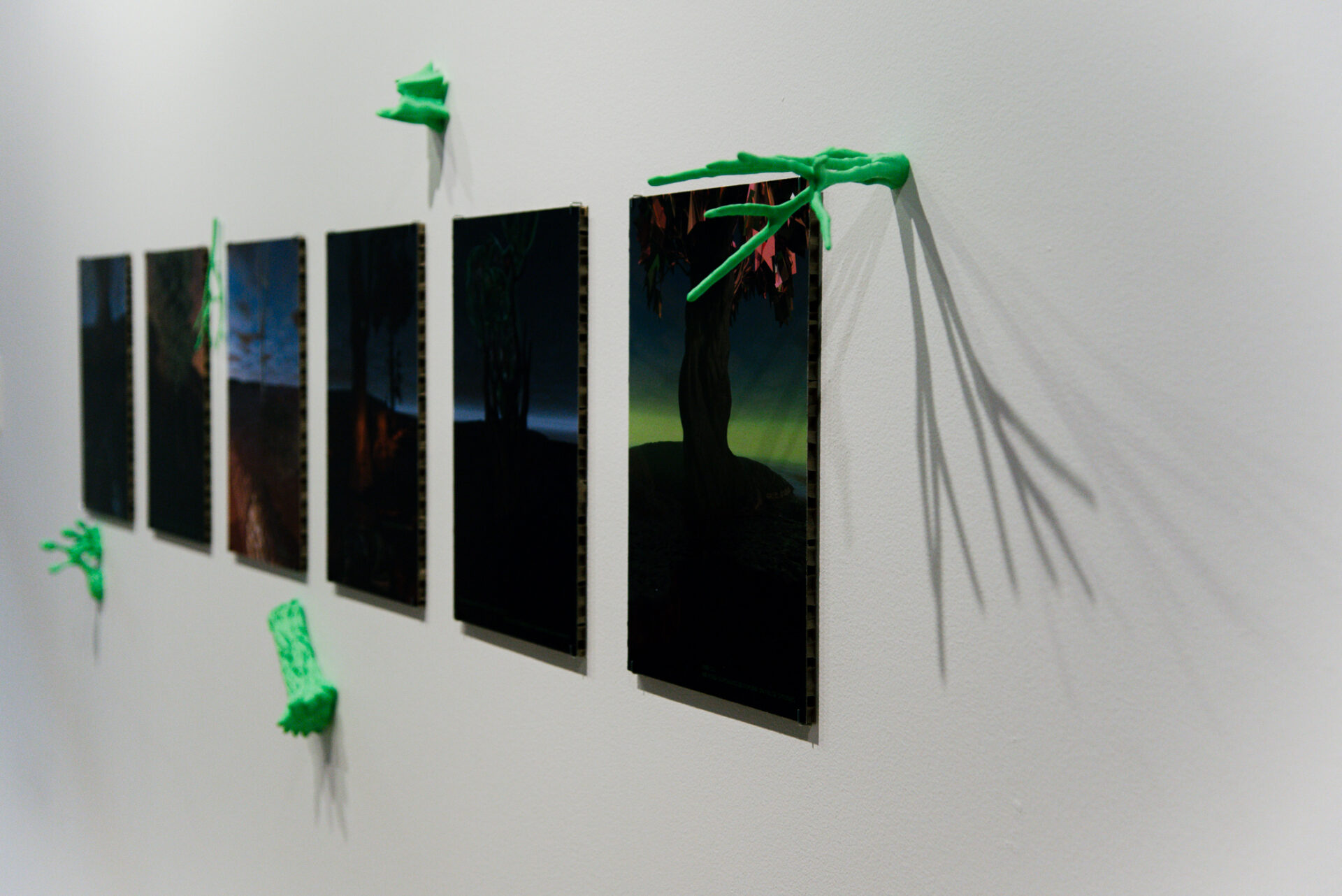
‘We Belong to Them’ by Sabine Šnē. Photo: Lelde Gūtmane

‘Face of the Universe’ by Tatsuru Arai. Photo: Lelde Gūtmane
Santa France, in her Still Life with Fruiting Bodies, presents a vision of symbiotic systems, drawing from the deep cultural and ecological significance of mushrooms in northern and Baltic societies. In these cultures, mushrooms hold a near-ritualistic importance, as each autumn brings a collective fervour to gather and share knowledge about foraging for mushrooms, despite it no longer being essential for survival. This seasonal tradition has become a cherished way to connect with nature, and to exchange knowledge on local forests and varieties of fungi, embodying a nostalgia that resonates deeply with the artist, who is currently based in Berlin. Her work interprets this symbiosis, exploring mushrooms as some of the most profound examples of interdependence in nature, reminding us of their role not just as organisms but as symbols of community and resilience in a changing world.

‘Still Life with Fruiting Bodies’ by Santa France. Photo: Lelde Gūtmane
Both Meditative Cohabitation by Studio Above&Below and My Want of You Partakes of Me by Sasha Litvintseva and Beny Wagner explore the intimate relationships that bind different life forms, examining the interconnectedness of existence through advanced technology and the visceral act of digestion. In Meditative Cohabitation, the focus is on fostering multispecies empathy within urban spaces, using bio-acoustic recordings and responsive visuals to immerse viewers in the sounds and rhythms of non-human life. The installation envisions future cities that integrate interspecies communication into their very design, advocating for technological empathy that extends beyond human needs. My Want of You Partakes of Me, on the other hand, delves into digestion as a metaphor for the absorptive, transformative processes that define all beings’ coexistence. Through multiple narrative layers, the piece touches on themes of metamorphosis and decay, power and vulnerability, as digestion becomes a poetic lens for exploring how we incorporate, consume, and are changed by the other. Both works challenge us to reconsider the borders of our bodies, cities and technologies, suggesting that the survival of one form of life depends on recognising and respecting the life around it, whether in a forest or within ourselves.
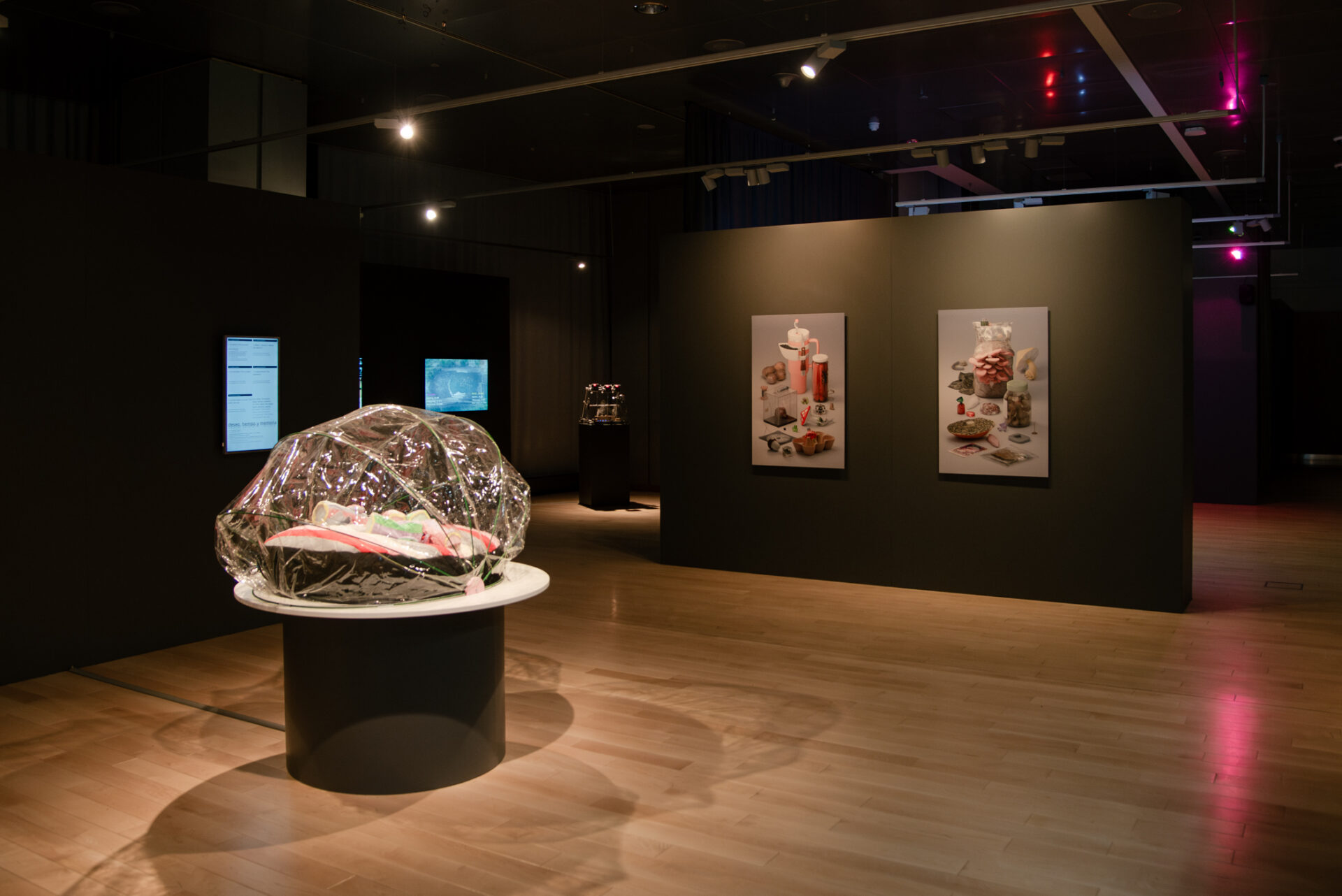
The Symbiotic Sense(s) Exhibition. RIXC Art Science Festival 2024, National Library of Latvia. Photo: Lelde Gūtmane
As I leave the exhibition, I am struck by the delicate balance between art and science. While this art, rooted in speculative visions and technology, does not aim to predict what lies ahead, it inevitably reflects our present hopes, anxieties and cultural intricacies. Yet I cannot help but wish it would push further, daring to envision what might come with a bolder sense of urgency. Amidst its precise, often data-driven, approach, I find myself longing for a more visceral expression, a rawness that could evoke understanding without explanation, capturing the unknown in a way that speaks to both intellect and instinct. Where are the new Bacons or Basquiats of this genre, artists who could take the language of AI, bio-acoustics, and complex ecosystems and translate it into something instinctual, untamed, even chaotic? This fusion of science and art has the power to not only map our futures but to remind us of the profound, magical strangeness of our present moment, if only it might loosen the reins a bit, embracing the wild possibilities of interpretation, and the emotional resonance that lingers beyond words.

The Symbiotic Sense(s) Exhibition. RIXC Art Science Festival 2024, National Library of Latvia. Photo: Lelde Gūtmane




